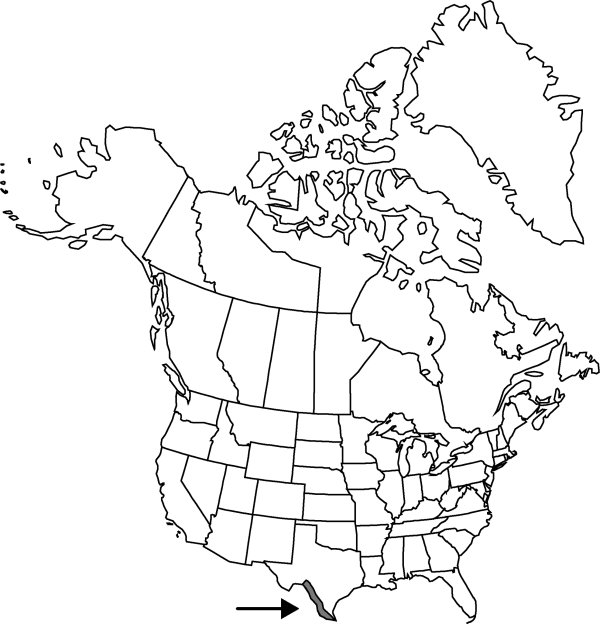Coryphantha robertii
Kakteen, 280. 1929.
Plants many branched, resulting in irregular masses of mostly immature stems that proliferate before reaching sexual maturity, clumps 10–30 (–100) cm diam., whitish bristly, spines nearly obscuring stem surface. Roots diffuse. Stems ovoid to cylindric, 3–6 × 1.5–3 cm; tubercles 4–8 × 3–5 mm, moderately soft; areolar glands absent; parenchyma not mucilaginous; druses in pith and cortex abundant but nearly microscopic; pith ca. 1/2 of lesser stem diam.; medullary vascular system absent. Spines (21–) 27–51 (–60?) per areole, snowy white or gray, except inner central spines pale-yellow or tan proximally, reddish-brown to nearly black in distal 1/2 or more; radial spines (18–) 24–41 per areole, (4–) 6–9 (–10) × 0.03–0.2 mm, adaxial 1–4 radial spines of fresh areoles on the largest stems greatly elongated, hairlike, ± contorted, semideciduous; subcentral spines 0–12 per areole; outer central spines (1–) 3–9 (–17) per areole, straight; inner central spines 0 (–1) per areole, ascending, descending, or porrect, other spines appressed or (usually) slightly projecting, some often descend from abaxial 1/2 of areole, (4–) 5–13 (–17.5) × 0.17–0.27 mm. Flowers nearly apical, 15–30 × 10–19 mm, sterile distal part of flower tube 0–2 mm, shorter than stamen-bearing part; outer tepals conspicuously fringed; inner tepals 14 per flower, sometimes shiny greenish yellow, usually with ± sharply defined midstripes of pinkish, brown, or brownish green, sometimes purplish-pink distally, margins and proximal portion white or cream, 8–12 × 1.5–3 mm; outer filaments white; anthers bright-yellow; stigma lobes 4 (–7), dark green to bright-yellow (rarely red), 1.5–2 mm. Fruits bright red throughout [sometimes green], ellipsoid, cylindric, or narrowly obovoid, 11–20 × 3–5 mm, not very succulent; floral remnant strongly persistent. Seeds black, even when fresh, ± spheric, pitted. 2n = 22.
Habitat: Dense scrub, often with Leucophyllum, Agave lechuguilla, Echinocereus poselgeri, or Lophophora, limestone, gravel, or silt substrates
Elevation: 50-400 m
Distribution

Tex., Mexico (Coahuila, Nuevo León, Tamaulipas).
Discussion
An earlier name, Echinocactus pottsiana Poselger, may apply to the species here called Coryphantha robertii. The type specimen is fragmentary with squashed, disintegrated spine clusters, one seed, and vague locality data.
Coryphantha robertii is like C. sneedii in almost all respects, including nearly all variations of growth habit, phyllotaxy, spine color, spine arrangement/dimensions, floral morphology, fruit color dimorphism, and in most variations of tepal color.
Selected References
None.